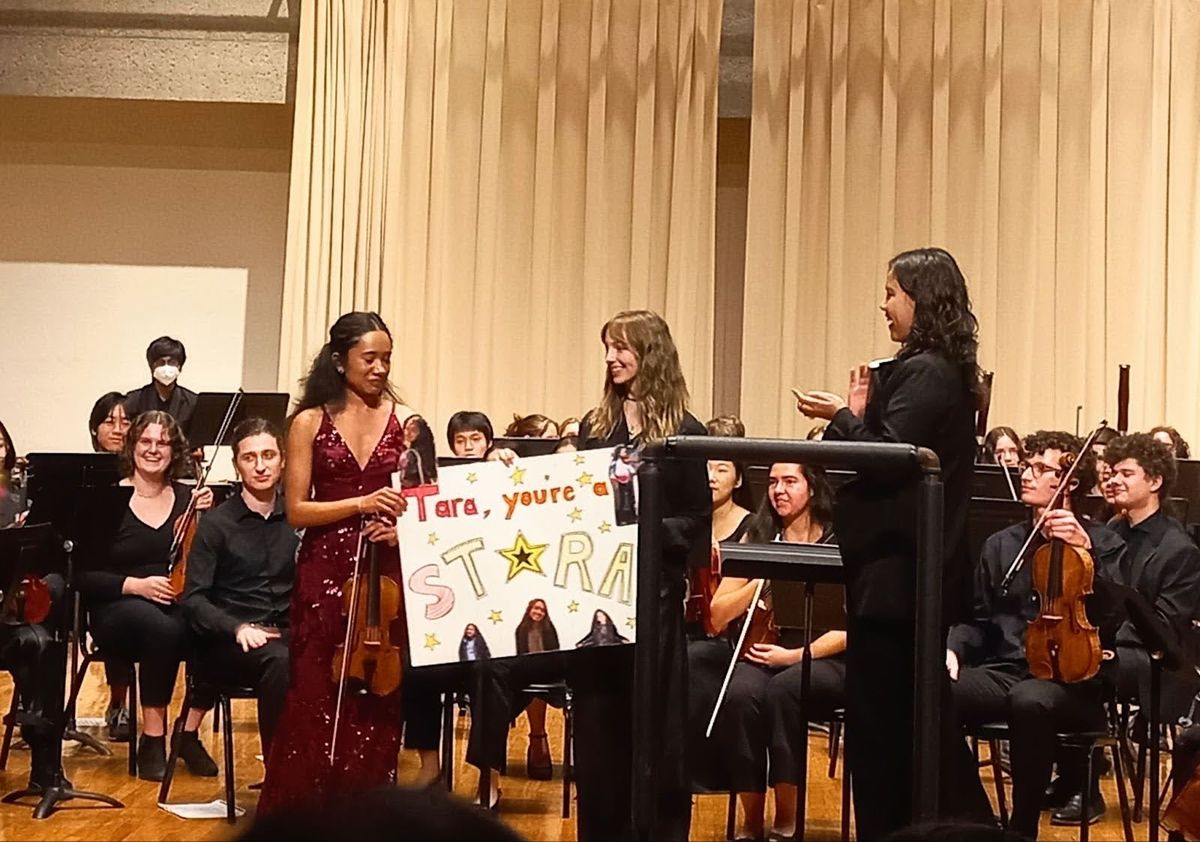ASO Welcomes Families with Tchaikovsky
The Amherst Symphony Orchestra performed a Family Weekend performance of Tchaikovsky’s masterpieces. Amaya Ranatunge ’28 covers the event, which featured a solo from Tara Alahakoon ’25 and a tribute to the late Professor Jeeyon Jeong.

Buckley Recital Hall was alive with music the evening of Nov. 1, as the Amherst Symphony Orchestra (ASO) performed in celebration of Family Weekend. The performance honoring masterworks of Tchaikovsky had two sections. First was the Violin Concerto in D Major, conducted by Assistant Director Charlotte Wang ’24 and featuring violin soloist Tara Alahakoon ’25. The second was a symphony conducted by Music Director Mark Swanson. It was dedicated to Jeeyon Jeong, the beloved Associate Professor of Biology who passed away in October.
The concert opened with the concerto, and the violins set the stage with a delicate yet intense introduction. This movement showcased the orchestra’s technical prowess and highlighted the extraordinary talent of soloist Alahakoon, whose performance President Michael Elliott called “spectacular” in an interview with The Student. Alahakoon’s playing was complemented by Tchaikovsky’s graceful melodies, which built in intensity as the orchestra joined her, and was marked by a captivating interplay of emotion and technical skill. The balance between soloist and ensemble was masterfully maintained, ensuring that the audience was never overwhelmed.
In this movement, the violins began with hints of emotional intensity, setting the stage for Alahakoon’s calm, melodic entrance. As she played, her melody slowly gained momentum, enriched by the orchestra’s harmonies. Alahakoon’s phrasing highlighted the violins, balancing the composition’s dynamics perfectly. As the piece approached its peak, the orchestral accompaniment paused, showcasing Alahakoon’s skill and proving her to be truly a spectacular violinist. Alahakoon says that she is “honored to have performed as a soloist along with her friends after participating in the orchestra since her first year at Amherst.”
The theme of the second half, as explained in Swanson’s introduction, was the need to cherish smaller moments in life, as they are what makes life beautiful.
The first movement of Tchaikovsky’s concerto transitions from a state of melancholy to a powerful crescendo. This journey captured a deep sense of longing, gradually evolving into a triumphant expression that resonated with the audience. The second movement, however, characterized by its softness and calm, provided a sense of hope and remembrance. Here, the orchestra embraced an introspective tone. The tranquility of this segment served as a poignant reminder of the impact that Professor Jeong had on her students.
Transitioning into the third movement, the orchestra turned towards luscious tunes. The orchestration was highly unique, featuring pizzicato string plucking. This vibrant section reinvigorated the audience, highlighting the versatility of Tchaikovsky’s composition. It was a playful, spirited segment that the listeners responded to with enthusiastic applause. It also has a contrasting middle section, which Tchaikovsky aimed to present as “a picture of drunken pheasants and a street song” with the woodwinds and the brass show “somewhere in the distance, a military procession” passing by, as stated by the program.
The concerto’s finale was a powerful culmination with a fortissimo rush of notes. The finale draws a festive image of joy, merriment, and wild celebratory music. Beginning with robust, triumphant themes, the symphony gradually shifted to softer reflections by adopting a Russian folk song, “In the Field a Birch Tree Stood,” in which a married woman sings to her lover. As the piece reached its ending, the joyous and festive music returned once more, suggesting how feelings can be simple and straightforward, thus we should find joy even amidst sadness.
The concert ended by paying homage to the late Professor Jeong. As President Elliott said during the interview, “It was a stupendous performance. The fourth symphony was astonishing, and it is extraordinary that they could perform it at such a high level as college students.” As the orchestra closed the night by sweeping the audience into Tchaikovsky’s masterpieces with beautifully sweet melodies and emotion in every note, it was no surprise that the night concluded with another standing ovation, leaving everyone excited for the next ASO performance. The finale resonated with Tchaikovsky’s words describing the symphony, already mentioned in the program: “Joy is a simple but powerful force. Rejoice in the rejoicing of others. To live is always possible.”





Comments ()